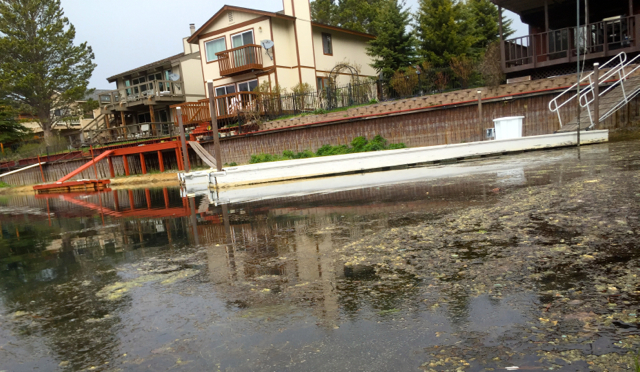Tahoe aquatic invasive species program takes hold

Milfoil was first discovered in the Tahoe Keys in the 1980s and curly pondweed in 2003. Photo/LTN
By Kathryn Reed
No one foresees the threat of aquatic invasive species going away, so permanent inspection stations for boats are probably going to become the norm in the Lake Tahoe Basin.
The first one is likely to be built in the Spooner Summit area. Nevada and U.S. Forest Service officials are studying it as part of the Highway 28 upgrades.
This is the 10th year the AIS program has been in existence under the purview of the Tahoe Regional Planning Agency. It’s a multi-faceted program that involves several agencies.
The goals include keeping out new invasive species and trying to reduce or eradicate the ones that exist.
Inspecting boats before they launch at Lake Tahoe is one way to keep AIS out of the water. In 2017 no new invasives were detected. However, there were 38 boats that were intercepted that had known AIS, with seven of those being mussels that can be devastating to a water body.
Of the 8,870 inspections conducted last year, 67 percent of the boats arrived here clean, drained and dry.
This season a new decontamination trailer will be used that should speed up the process and mean fewer trips around the lake by the service technician. Truckee will be getting new equipment so it can handle more complex boats.
While it’s not mandatory yet, TRPA is lobbying state and federal officials for inspections when boats leave a body known for having invasives – especially mussels. Lake Mead is one of those areas local officials would like to see have more stringent rules because it has the destructive mussels.
“Education is key so the public understands what we are doing and why,” Dennis Zabaglo, TRPA aquatic resources program manager, told the TRPA board at its meeting March 28 in Kings Beach.
Besides inspecting boats, the agency with partners are using a variety of techniques to curb infestations already in the lake. Some are more successful than others.
The UV light pilot project at Lakeside Marina to get rid of invasive weeds has been positive, with monitoring continuing.
Mats used on a 6-acre plot at Sand Harbor to stamp out the clam problem didn’t work as planned, with the infestation spreading to 20 acres. TRPA is working with Nevada agencies to chart another course. A clam harvester could be the next tool that is used.
Tahoe Keys and Ski Run Marina are two of the problem areas. The Keys has submitted an application to regulatory agencies to use herbicides in the canals of the South Lake Tahoe neighborhood. A decision has not been made to grant that request.
Officials continue to look at all available resources including LiDAR, aeration system and working with the boating industry to develop engine components that would keep out AIS.
The rapid response plan in case there is a serious threat detected will be revised this year, which will include a practice scenario.
TRPA is also finding that lab results are taking longer because more agencies are testing for AIS. A secondary lab has been secured if needed.


